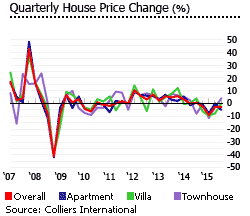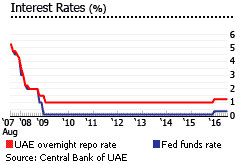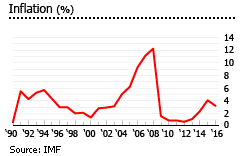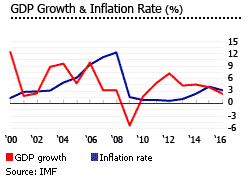House prices in UAE are still falling
 Property prices in Dubai are still declining, following an unsustainable surge in recent years.
Property prices in Dubai are still declining, following an unsustainable surge in recent years.
In May 2016, Dubai´s all-residential property price index (RPPI) fell by 5.35% y-o-y, according to Reidin.com. When adjusted for inflation, house prices in Dubai fell by 6.86%.
- Apartment sales prices in Dubai fell by 5.15% (-6.67% in real terms) during the year to May 2016.
- Villa sales prices fell by 6.05% (-7.55% in real terms) over the same period.
Dubai’s RPPI is calculated monthly and covers 7 cities, 8 main districts and 4 major projects.
The continued sales price decline, according to JLL MENA, is due to:
- the stronger US dollar, which hit the purchasing power of overseas investors from non-US denominated countries;
- lower oil prices similarly cut the purchasing power of investors from nearby oil-producing nations.
Dubai´s property transactions dropped by 25% y-o-y in terms of value in the first quarter of 2016, while transaction numbers were down by 17% y-o-y. The total value of transactions was AED 267 billion (US$ 72.7 billion), 49% of which were sales, while 44% were mortgages. Dubai´s residential price declines were slower than in the previous months, suggesting that the market may be close to bottoming out.
Most residential housing demand in Dubai has recently come from Indian, British, and Pakistani buyers.
In contrast, Abu Dhabi´s all-residential property price index rose by 1.34% during the year to May 2016. However, when adjusted for inflation, Abu Dhabi´s residential property prices were down by 0.27%.
- Abu Dhabi apartment sales prices fell by 0.61% (-2.2% in real terms) y-o-y in May 2016.
- Abu Dhabi villa sales prices rose by 3.15% (1.5% in real terms).
Abu Dhabi’s RPPI is also calculated monthly, and covers 7 cities and 4 main districts.
Abu Dhabi sales prices have been stable during the first quarter of 2016 due to a decline in completions, according to JLL MENA. Demand for high quality residential units remains strong, according to Asteco. The Saadiyat Island development project is still the most popular location, followed by Reem Island and Al Raha Beach.
The softening of property values in Dubai is expected to continue this year, according to Cluttons. Due to factors such as global economic conditions and higher costs of buying properties (partly due to the Federal Mortgage Caps), a recovery in the housing market seems unlikely at this point in time.
Deloitte also predicts further declines in the average sales prices in 2016, stating that this reflects " a transition to a more mature market as well as an increase in more affordable stock and discounting in emerging locations".
“The prospects for 2016 suggest a further soft landing in the real estate sector. Although demand continues to grow, the rate of growth is slowing as the overall economy adjusts to a sustained period of lower oil prices.
"While there are significant levels of new development in the pipeline, most of this supply is being phased over many years and the supply pipeline for 2016 does not look to be excessive. The prospects for 2016 will therefore be determined more by changes on the demand side rather than any great threat of oversupply. With the economy continuing to grow (latest IMF forecast is for a 3.1 per cent growth in real GDP in 2016) most sectors of the real estate market are likely to see a soft landing, with either stable or relatively minor falls in prices and rentals,” says JLL MENA´s Head of Research Craig Plumb.
In the first quarter of 2016, Dubai´s total residential stock was about 458,500, while the total residential stock in Abu Dhabi was about 246,000, according to JLL MENA. In September 2016 around 27,000 new housing units were expected to have entered the Dubai market, and around 4,000 new housing units in the Abu Dhabi market.
The Federal Mortgage Cap, introduced in 2013, has slowed the pace of residential value appreciation in Abu Dhabi and Dubai. In addition, the Dubai Land Department recently doubled property registration fees from 2% to 4% to dampen property demand.
Foreign ownership has been significantly liberalized:
- Foreign nationals are now allowed to buy freehold properties in designated areas in Dubai.
- Gulf Cooperation Council (GCC) nationals are allowed freehold ownership anywhere in the Emirates.
- Abu Dhabi´s government introduced new regulations in 2014 allowing foreigners to own property in designated investment zones on a freehold basis. Previously, foreign investors were generally limited to leasehold arrangements with 99-year leases. This followed Abu Dhabi´s previous market-boosting measures. In 2012, the government compelled public sector employees living outside Abu Dhabi to relocate within the emirate’s borders. Then in November 2013, the government cancelled a 5% cap on annual rent increases.
The great crash - a history lesson

From 2002 to 2008, Dubai’s property prices almost quadrupled, and large-scale developments turned Dubai into one of the fastest growing cities in the world. Some of the biggest projects include Jumeirah Garden City (estimated cost: US$95 billion), Dubailand (US$64 billion), The Lagoons (US$25 billion), Palm Jumeirah (US$14 billion), and The World (US$14 billion).
After March 2006, a deluge of foreign money boosted Dubai’s ambitions following the passage of the long-awaited foreign property ownership law. Europeans, including Russians, accounted for 20% of the buyers of all property categories. GCC, Arab nationals and UAE nationals made up 28%, Asians 40%, and Iranians 12%, according to figures from Global Realty Partners. The overall foreign ownership index of property kept by Colliers International soared 116% from Q1 2007 to Q3 2008.
Then the global credit crunch hit. Amlak and Tamweel, the UAE’s two largest home finance companies, stopped offering new mortgages. Foreign investors disappeared at the end of 2008, as the global financial crisis hit. Transaction volumes plummeted. The overall foreign ownership index was 50% down by Q4 2010, from its peak in Q3 2008. Almost half all construction projects in the UAE, worth around AED1.1 trillion (US$582 billion), were either put on hold or cancelled.
There was a budding property market recovery in Dubai from Q4 2011 to Q1 2012, and Abu Dhabi followed suit. As the economy returned to growth, halted construction projects were resumed. From January 2012 to end-2014 Dubai experienced skyrocketing house prices, averaging 21.5% annually.
However, house price growth in Dubai slowed by end of 2014. In 2015, Dubai´s all-residential property price index (RPPI) dropped by 11%, and Abu Dhabi´s RPPI fell by 0.8%.
The price drops in 2015 were due to:
- the significant drop in global oil prices
- the strengthening of the US Dollar
- geopolitical tensions in the Middle East
- the higher cost of buying property due to the cooling measures implemented by the government in previous years - including the central bank´s Federal Mortgage Cap.
Benchmark rate hike after nine years

Dubai´s central bank decided to raise its benchmark rate by 25 basis points to 1.25% on December 17, 2015, a day after the US Federal Reserve announced a rate hike.
Mortgage interest rates in Dubai have, in the past, followed key US Fed rates, because the dirham (AED) is pegged to the US dollar at AED3.67 = US$1. In 2008, when the Fed successively cut key rates, the UAE’s central bank was forced to track US monetary policy, causing inflation to hit a record high of 12.9%.
New mortgage rules

The UAE’s mortgage market has expanded rapidly in recent years. In 2015, aggregate loans, advances, overdrafts and real estate mortgage loans rose by 9.5% to AED 965.5 billion (US$ 262.9 billion), after rising 10.4% in 2014 and 2.5% in 2013, according to the Central Bank of the UAE. Mortgage loans grew from 2.7% of GDP in 2001, to 11.7% of GDP in 2012.
Tamweel, one of the largest Islamic mortgage lenders, is back in the market, having stopped trading its mortgage shares in November 2008 due to the global credit crunch.
More fixed-rate mortgage products have been introduced. In addition “fee free” products, which allow borrowers to switch to a new lender at a lower cost, have been offered starting during the last quarter of 2010.
In 2013, the Central Bank of UAE introduced a new set of mortgage regulations to cool the property market. The new LTV rates are as follows:
UAE FEDERAL MORTGAGE CAPS (MAXIMUM LOAN-TO-VALUE-RATIO) |
|||
| First home (Owner-occupier) | Second home or investment property | Off-plan purchase | |
| NATIONALS | |||
| Property valued under | 80% | 65% | 50% |
| AED5 million (US$1.36 million) | |||
| Property valued over | 70% | 65% | 50% |
| AED5 million (US$1.36 million) | |||
| EXPATRIATES | |||
| Property valued under | 75% | 60% | 50% |
| AED5 million (US$1.36 million) | |||
| Property valued over | 65% | 60% | 50% |
| AED5 million (US$1.36 million) | |||
| Source: UAE Central Bank, Cluttons | |||
New rent cap law in Dubai favours landlords; now no rent cap in Abu Dhabi

A new rent cap law, Dubai Decree No. 43/2013 (the “New Decree”), came into effect in Dubai on December 18, 2013.
This new decree has the same 20% cap as the previous rent cap law (Decree No. 2 of 2011, known as the “the Old Rent Cap”). However, it shifts the balance of power in favour of landlords, who can now increase rents on lease renewal, or as soon as the rent for a property falls 11% below the average market rental rate.
The New Decree also makes clear that the rent cap also applies to special development areas and free zones, including the Dubai International Financial Centre (DIFC).
NEW RENTAL LAW |
|
| CURRENT RENTAL RATES | RENT INCREASE FOR 2013 |
| if existing rent is: | |
| Equal to or 10% below the average rental rate | Nil |
| 11% to 20% below the average market rental rate | 5% |
| 21% to 30% below the average market rental rate | 10% |
| 31% to 40% below the average market rental rate | 15% |
| More than 40% below the average market rental rate | 20% |
In Abu Dhabi, the Executive Council cancelled the extension of the annual 5% rent increase rate from November 10, 2013, implying that the 5% rent cap was being removed. This was expected to boost competition among tenants. But in fact it caused some confusion for landlords, who were accustomed to increasing their rents by 5% every year.
Abu Dhabi´s new real estate law (No. (3) of 2015) does not indicate a new rent cap, suggesting that landlords can now freely set rents.
In addition, the new law appoints Abu Dhabi’s Department of Municipal Affairs (DMA) as real estate regulator, performing the same functions as Dubai´s RERA. The reforms, as outlined by The National, include:
- A central government database/register for all property projects in Abu Dhabi, including off-plan sales;
- Developers are only allowed to charge DMA-approved administrative fees, and are barred from collecting registration fees from investors;
- Rules are laid down for the creation of owners´ associations;
- Developers are allowed to sell off-plan units as long as they own a real estate right over the project land. A "disclosure statement" is also required, providing information on the development to home buyers.
- Developers marketing off-plan units are required to open an escrow account.
- In case of "substantial prejudice", off-plan buyers can terminate their purchase.
- Developers will be fined by the DMA if their projects are delayed by more than six months. If there is a significant delay, the new law allows for cancellation of projects or the appointment of anew developer.
- A 10-year liability period for developers regarding structural building defects.
Lower rents in Dubai and Abu Dhabi
Residential rental rates declined in both Dubai and Abu Dhabi during the first quarter of 2016, according to Asteco.
- In Dubai, the average apartment rental rates fell by 2% in Q1 2016 from the previous quarter, according to Asteco. On an annual basis, the rental rates fell across the board at an average of 4%.
- In Abu Dhabi, rental rates for prime residential apartments declined by 2% from the previous quarter. However, rentals were still up 4% on a year earlier.
In Dubai, annual rents in Q1 2016 ranged from AED 45,000 (US$ 12,253) to AED 170,000 (US$ 46,290) for one-bedroom apartments, and from AED 80,000 (US$ 21,784) to AED 340,000 (US$ 92,580) for large three-bedroom apartments, according to Asteco.
Abu Dhabi rents ranged from AED 42,000 (US$ 11,436) to AED 150,000 (US$ 40,844) for one-bedroom apartments, and from AED 65,000 (US$ 17,699) to AED 350,000 (US$ 95,303) for three-bedroom apartments.
Rents in specific developments:
- At the Discovery Gardens, annual rents for one-bedroom apartments range from AED 65,000 (US$ 17,699) to AED 73,000 (US$ 19,878); and two-bedroom apartments from AED 75,000 (US$ 20,422) to AED 100,000 (US$ 27,229).
- In International City, annual rents for studio apartmentsdranges from AED 32,000 (US$ 8,713) to AED 40,000 (US$ 10,892), while rents for one-bedroom apartments range from AED 45,000 (US$ 12,253) to AED 52,000 (US$ 14,159).
- At the Golf Gardens, located next to the Abu Dhabi Golf Club, annual rents were from AED 220,000 (US$ 59,905) to AED 230,000 (US$ 62,628) for a three-bedroom villa.
- Annual rents for three-bedroom apartments in MBZ City start at AED 65,000 (US$ 17,699).
Attractive yields in Dubai
Gross rental yields in Dubai are moderate to good, ranging from 5.40% to 7.39%, according to the Global Property Guide´s research of August 2014. Smaller apartments (50 – 85 sq. m.) have higher yields, averaging 7.29%, while larger apartments (120 – 175 sq. m.) have yields averaging around 5.71%.
Slower UAE economy in 2016; VAT to be introduced in 2018

The UAE is estimated to have grown by 3.1% in 2015, according to UAE’s Minister of Economy Sultan Bin Saeed Al Mansoori. He added that the government is still optimistic regarding UAE´s economic outlook despite oil price drops, because diversification policies have helped neutralize the oil price drop´s impact.
The UAE´s economy grew by 4.6% in 2014 and 4.3% in 2013, despite the collapse of oil prices during these years.
According to the central bank, Brent oil prices were down by 36% during the year to Q1 2016, and down by 21% from the previous quarter. Continued oil price falls pose a challenge to the UAE´s target of more than 3% growth in 2016.
“It’s a challenge, not only for us but for everyone around the world, so it will all depend on the prices of oil as we move on,” said Al Mansouri. However with oil-related businesses currently accounting for only 30% of UAE´s economy, the UAE is "much more prepared to handle these kinds of challenges".
In response the UAE´s Cabinet approved a slightly tighter federal budget, with cuts to subsidies of AED 3.5 billion (US$ 953 million).
The IMF revised down UAE´s 2016 growth forecast to 2.4% in April 2016. Dubai´s GDP is expected to expand by 3.7%, while Abu Dhabi´s will expand by 1.7%. “While there are clear divergence in growth trends in Abu Dhabi and Dubai, we expect to see higher growth in Dubai because of the diversified nature of the Emirates economy," said Masood Ahmed, IMF’s Middle East and Central Asia Department director.
Non-oil sectors account for around 69% of the country’s GDP, while the remaining share is oil. Driving the country’s economic diversification is the Abu Dhabi’s Economic Vision 2030, and Dubai’s Strategic Plan 2015, which aims to increase investment in industrial and export-oriented sectors. At the federal level, the UAE´s "2021 Vision" positions science and technology, research, and innovation at the centre of a knowledge-based and highly competitive economy by 2021.
The government expects to cut oil´s contribution to GDP from 30% to 20% by 2021, according to Al Mansoori. “Our strategy at present is focused on building a knowledge based economy."
The UAE’s inflation rate rose to 3.2% in May 2016, according to National Bureau of Statistics. The substantial price hikes observed in May was in transportation, while significant price drops were seen in food and soft drinks.
The UAE government will implement a 5% value added tax (VAT) on January 1, 2018, says Minister of State for Financial Affairs Obaid Humaid Al Tayer, as part of efforts to diversify revenues. The move is expected to bring higher inflation, at least temporarily.
"The short-term impact will be offset by the long-term benefit VAT will bring to the regional economies. There is an urgent requirement to diversify government revenues...VAT is a measure that will allow more stability, given that the outlook for crude prices remains volatile," said Amer Khansaheb, President of the Emirates CFA Society.